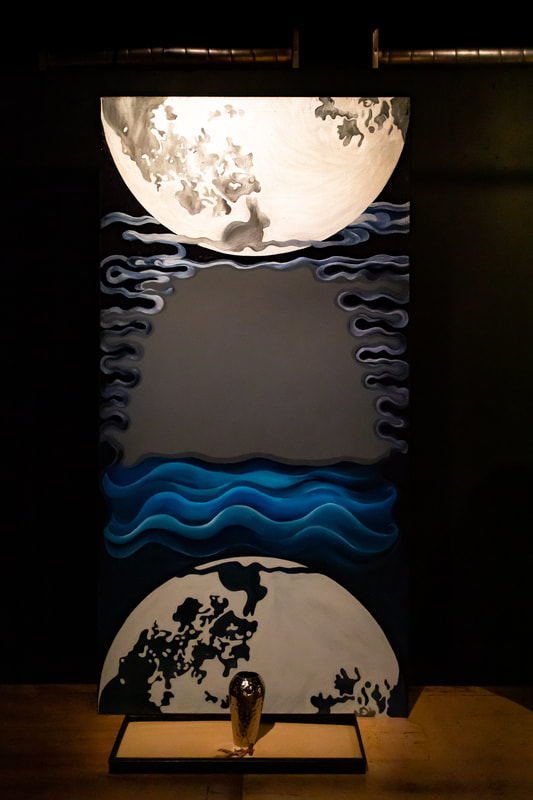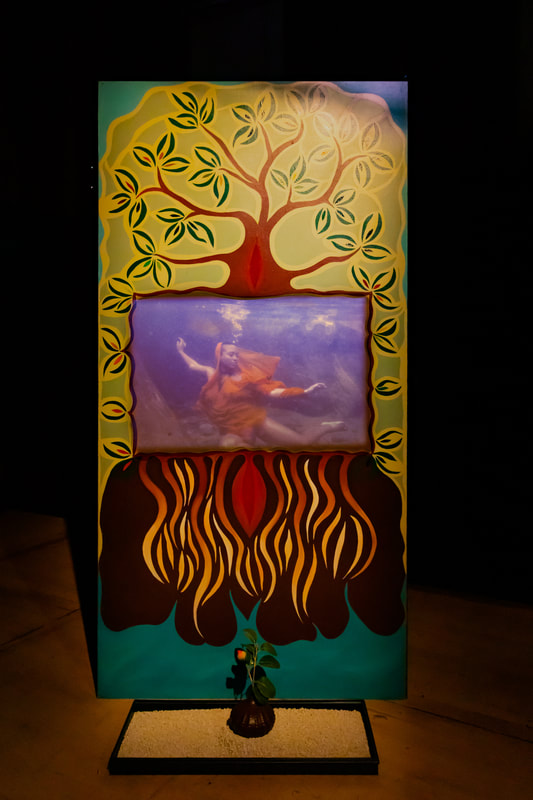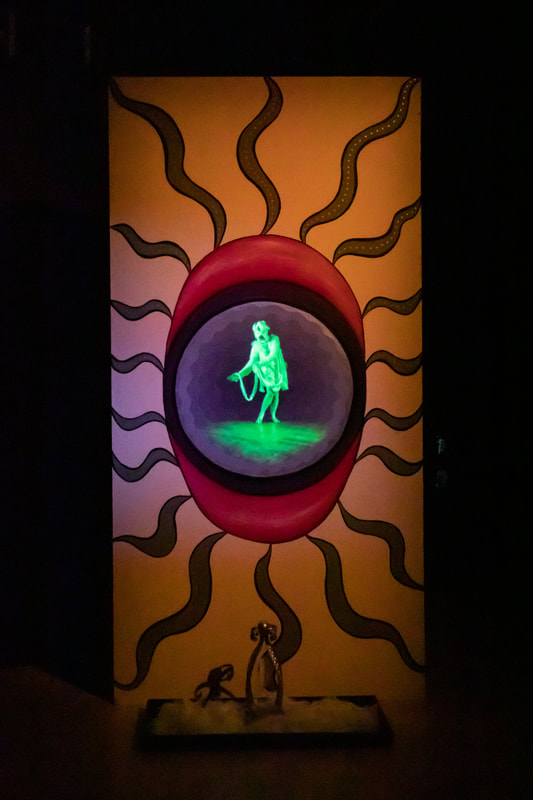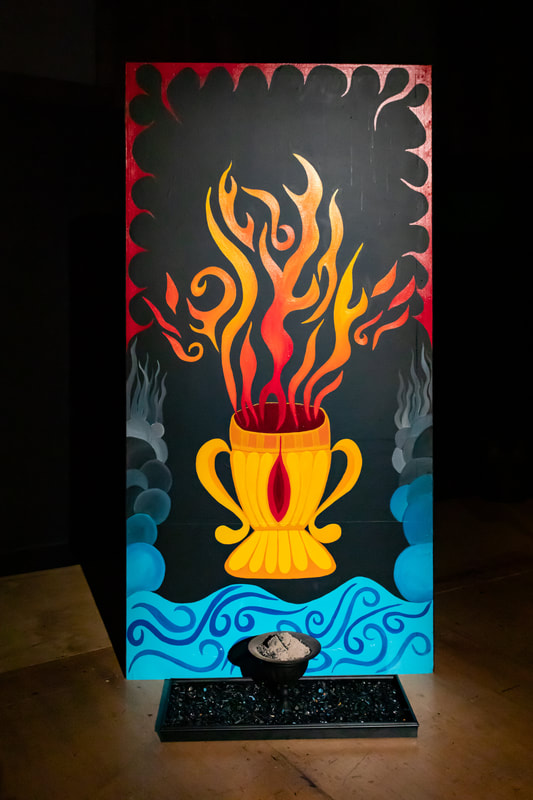In the winter of 2020, I was told that there was a live theatre production happening in Portland. At that time, I had gotten so accustomed to the artistic void that had consumed the world that I didn’t believe it at first. I wasn’t incredulous, I wasn’t awe-struck, I simply didn’t believe it. I had been told so many times that art was being made and persisting, and I had seen productions die and wither away just as many times. I was told that Shaking the Tree was putting on a live theatre production and I was so hollowed out by disappointment that I just didn’t have it in me to believe.
As it happened, this rumor was real. Samantha Van Der Merwe, Shaking the Tree’s Artistic Director, had devised and directed a live visual art piece for Portland. It was called Refuge and it was her gift to a pandemic-stricken town, a gift that brought a profound sense of connection and emotional engagement for me and my trauma-bonded pod that went to witness it together. I had read a little bit about the show before entering the theater; I knew that it was a visual art piece with sound and light design, I knew that it would be performed for one pod at a time, and I knew that it included a pantheon of goddesses welcoming us into divine belonging.
Refuge at Shaking the Tree – Photo Credit: Gary Norman
What I experienced at Shaking the Tree that night was no less than extraordinary. My dearest community members and I, alone, wandered the space and listened as tall panels that Samantha had elaborately decorated with goddess iconography were lit up and spoke to us. Every panel had been emboldened by a collaborator artist, someone who had created an additional soundscape to characterize the goddess that was addressing the audience. We walked in circles, just as hundreds of audience members had before us, and gazed into the face of this art. We received a nourishing reminder of imagination that night, something I hadn’t realized I needed until it was given to me.
I was honored to sit down with Samantha, Rebby Yuer Foster, and Bridge Donnelly. These three artists and administrators at Shaking the Tree had intimate connections to Refuge and were kind enough to share their thoughts on the project with me. What emerged from our conversation was a delicious reckoning with unexpected diversion in theatre and a glimpse into a new, more radical world of art sharing. I hope you enjoy these three beautiful minds as much as I did.
Shifting the Theatre’s Consciousness
Q: What was your involvement in Refuge?
Rebby: I created the video for Our Lady of Lunar Reflection. It was a video piece that involved my mom and a few friends. I interviewed people about what the moon meant to them and what steps they think we should take as individuals and as a collective to move forward. Thinking more in the collective mindset- of humanity, all humans. I shot that and I shot B roll of people painting and skating and things. It somehow all tied together. Samantha: I conceived the piece and then I brought collaborators on as it progressed. That was my role in the whole thing. And I painted the panels.
Samantha: I conceived the piece and then I brought collaborators on as it progressed. That was my role in the whole thing. And I painted the panels.
Bridge: Every single panel! And they’ll be up for auction soon! During Refuge, I was the box office person. I greeted each pod as they entered into the space and asked for donations and made sure they had their masks on and all of that. Sam and I talked about me being almost like the priestess of the space because it was a space inhabited by goddesses, so I felt less like a box office person and more like a guide. I was also Production Assistant on the film that Rebby.
Our Lady of Lunar Reflection
Photo credit: Gary Norman
Q: How was this show a response to the circumstances of the pandemic?
S: It was such a crazy time for theaters, we didn’t know how to proceed with anything. We were all stuck at home. We had just gone into lockdown. I remember sitting at the dining room table, looking out the window. I have these lovely trees outside- wondering what I was going to spend my time doing. It just came quickly, sometimes ideas just zoop! They come on in and they’re there! So I wrote it down. I think what compelled me was that I love to paint. So I was like, “what would bring me real solace and refuge right now?” To spend my time painting! We had all these flats stacked up at the theater, so I could do it for free. At the time, we didn’t know if we were going to get any emergency funding or anything. It was just a matter of thinking of how I could spend my time and what that result would be. The result would be that I have a gift to offer people for free. To create a space that felt like a sacred circle of stones for them to just walk into. It didn’t matter if there was one person or three people or five people. That’s how it began. That was the response. And then we just moved through so many crazy phases of the pandemic – the racial reckoning came about. I realized I didn’t want it to be my story, I wanted it to be a collective story. That’s when I reached out to collaborators and said “I am going to create these different goddesses, is there one you feel connected to? Would you like to write something in response to that panel or write a film or create a piece?” So that’s what happened.
B: The process was really long. Sam started painting the panels in March 2020 and the show went up in January 2021. It wasn’t even so much a response to the pandemic so much as it was working with the pandemic, working through the pandemic. It changed and warped so much. I remember coming in here last August to do mutual aid stuff with Rebby and seeing Sam painting away. It was vague, she was just feeling her painting. Then a year later I hear about this project and Rebby is like “Oh, I’m going to make this film, wanna be my PA?” A few months later, Rebby is like, “We need a box office person for this show!” And I was like “Ok!” And the show ran for a long time as well. It ran from the end of January and was extended through May. We had 500-600 viewers, which is a lot. And all the tickets were completely free. It really wasn’t even a response, it was shifting the theatre’s consciousness with COVID and I think that the structure of our theatre has changed because of COVID. It was really nice to have these stories to hold onto and refer back to. I think it’s going to be really exciting when the Refuge book comes out, it’s going to be a printed book with the script. It will be really cool to look back and say, “Wow that really got me through the first half of 2021.” And it got Sam through 2020.
S: Yeah, it really got me through. We were all working from home, and I had two grown kids who were living at home at the time. And my husband was working in the basement and each of us was working from our rooms. So I would do emails in the morning and strategize and do damage control, trying to figure out how we were going to survive as a theater. And then I would leave and come to the theater and paint for the rest of the afternoon. I did that every single day starting in March. I realized how lucky I was to have the space to do that and to have the materials. I had paint, I had flats. It got me through artistically. It felt really selfish because I would never get the opportunity to just spend five hours a day painting. Giving that to myself allowed me to then spread it out, it created all this other opportunity.
B: Yeah, you were able to hire 11 other collaborators. And then each of those people hired others under their stipend. So talk about community cultivation! Like, literally spreading the love! Because Sam was like “I love this theater and I wanna keep it going, so I’m just gonna come in and paint, I’m gonna give this gift.” And it was for everyone at the end of the day.
People-Focused Rather than Product-Focused
R: I don’t think something on this timeline would have happened if we weren’t in this pandemic.
S: It forced us to slow down and think about what was the most important. For a lot of people I’ve spoken to it helped us shift perspective. It forces us to ask ourselves, “Why can’t we take that long to do another project?” Why do we have to turn out three projects? Can we just do one or two that require a little bit more up-front work? We know that the result will be so satisfying. We know that it couldn’t have been executed in the normal period of time that we give ourselves.
 Q: How has working on this project in it’s long timeline changed the way that you understand what theatre is for you? What was this process’ impact on your concept of your art?
Q: How has working on this project in it’s long timeline changed the way that you understand what theatre is for you? What was this process’ impact on your concept of your art?
R: It empowered me to do film and to create things outside of what I was trained in and believed I knew. That has been really empowering, you don’t really need to be technically trained in an art form in order to create something that feels fulfilling. And then also, Refuge was very people-focused rather than product-focused. It focused on the collaborators. It held and cared for each individual audience member a lot more because there weren’t that many people in the space at a time. That’s something I want to continue doing. Before the pandemic, I was working as a freelance actor and model. So I was like, “I have to get this money, I have to get these jobs!” In the industry, you have to kill to get the job. Refuge and the other projects I’ve worked on over the pandemic have shifted my mindset to be more people-focused, whether that be the collaborators I’m working with or myself.
S: I agree. We are planning a project for 2023. It liberated me to think about the audience members, just like Rebby said. In the past, if I wanted to build a show where people were moving from room to room, I was like, “Well I need to get 60 people in here so there’s 8 people per room.” It’s always a numbers thing. This process has allowed me to be like, “No, I can have two people in a room at a time. It just has to be a longer run if we want enough people to see it.” We could run something for 10 weeks rather than 5 weeks. It’s interesting to be more open after having set those parameters for myself in the past. It was all based on numbers and the amount of money we needed to get in. And now we have seen a way of doing it where you can fund it without having a bottomline in mind. You have to get more funding for it, but that’s something we’re willing to do because it makes such a special event for the audience, such a bigger gift. So why not make people wait longer to get it, why not put that extra work into it if you know it’s going to be this really special thing? It’s almost an abundance mindset. I think theatre was operating on such a scarcity mindset.
B: I agree. Refuge significantly expanded my conception of art for a few reasons. As someone who was assigned female at birth (AFAB), was raised as a female, and no longer identifies as one, it was really cool to walk into a space and be fully aware that all of the collaborators were queer or AFAB. Walking in and seeing that Sam had painted all these panels and that my best friend in the universe, Rebby, had made this film… And then I heard Refuge probably like 300-400 times. I heard that poetry so many times. It was so neat to realize that these are real humans that Sam knows, that Rebby knows, who are writing poetry that moves me more than most poetry has. Then audience members would ask if I had made the paintings. And at first, I thought that was the most hilarious, out-of-this-world question! I was like ‘Huh?! You think this is my theater and my paintings?! Who the hell do you think I am?!’ But I think what was really key about that was that it very well could have been me if I wanted to. I very well could make my own 12 panel show if I fucking wanted to ‘cause my boss just did it and paid 11 BIPOC collaborators to create this piece. I have a pretty flowy conception of art, so to expand it is quite a feat, I think. I’m a malleable person, I like interactive art. I think the really key piece of Refuge, for me, was seeing that anyone could do it if they wanted to. It was hugely inspiring.
We Don’t Keep that Confidence for Ourselves, Because There’s no Scarcity
R: I think I learned the same thing through Refuge and other things that have been done and planned by me and my friends over the pandemic. You can do whatever with whoever with whatever on whatever timeline, you can just make it happen. It’s kinda ridiculous how tangible everything feels.
 B: And for Lady of Lunar Reflection, which was a 4-minute video, Rebby and I talked about that video for hours. It started our ongoing conversation about film as a meta-art that captures other art. It enabled us to be more confident creators, which is huge and really important. ‘Cause we don’t keep that confidence for ourselves, because there’s no scarcity, so we spread it to our friends and try to bring other people into our community.
B: And for Lady of Lunar Reflection, which was a 4-minute video, Rebby and I talked about that video for hours. It started our ongoing conversation about film as a meta-art that captures other art. It enabled us to be more confident creators, which is huge and really important. ‘Cause we don’t keep that confidence for ourselves, because there’s no scarcity, so we spread it to our friends and try to bring other people into our community.
Q: What do you hope theatre will bring forward with it from all of this experimentation and adaptation?
R: It’s hard. I know how I want to move forward and I know what things I want to hold onto and what I want Shaking the Tree to hold onto. I already see people who are creating things and falling back into the same patterns and telling the same stories, like literally doing the exact same scripts or pieces that they were going to do pre-pandemic. I understand that you can still be passionate about that same piece, it just makes me a little disheartened because so much has changed but people are still trying to hold onto the normalcy of what they think theatre is. There’s comfort in latching onto things.
Theatre is Anything with a Story
S: It’s a matter of permission and agency. We’re so into labeling and classifying things, we’re like, “This is a theatre piece, and this is a dance piece, and this is a film piece, and this is a visual arts piece.” For me, it always overlaps. I had such a dilemma asking myself how I could make a visual piece as a theatre, saying, “No one will come because we are supposed to deliver theatre.” But theatre is anything with a story, anything that offers you an experience that is outside of your normal self. It’s about giving ourselves permission. Going forward, we know that anything that Rebby wants to get their hands on involves film because it’s a medium that they love. You might see a theatrical piece that’s heavy on the film side. I’m going to keep giving myself permission to paint and create these structures for people to walk into because I want people to experience something in the middle of visual art and story. We are so visual right now because of being so tapped in online, we just stare at things every day. I think it’s just about not falling into traps of labeling things and just being like, “This is what this is going to look like! It doesn’t matter what it’s classified as. Can everyone get on board?” ‘Cause even when I write a grant, I don’t know if I should put it in the theatre category or the multidisciplinary category, what is it? Why should I have to label it?
These three wonderful artists at Shaking the Tree reminded me, again, why we make art. We make art to serve our communities and ourselves, to create things that are spiritually, emotionally, and socially nourishing to us. This is something that is easily lost in the fast-paced, bottom-line world of pre-pandemic theatre. I agree with Samantha, Rebby, and Bridge in their assertion that theatre is better when it’s slower, kinder, and more curious. 
Thank you for reading their stories and joining us in the cultural shift to foster a more abundant theatrical model. Please visit Shaking the Tree at their website and pursue their archives to get a peek into the sacred gift Refuge was. Catch us next time when I sit down with Emily Newton, one of CoHo’s favorite clowns, to ask for her perspective on theatre’s evolved form. Feel free to donate to CoHo and Shaking the Tree, fund the community-centered creativity we strive to deliver.








